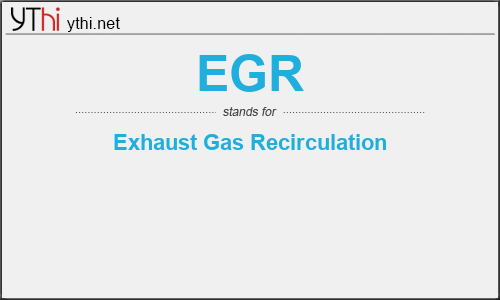What does EGR mean? What is the full form of EGR?
The full form of EGR is Exhaust Gas Recirculation
Exhaust gas recirculation (EGR) is an emission control technology allowing significant NOx emission reductions from most types of diesel engines: from light-duty engines through medium- and heavy-duty engine applications right up to low-speed, two-stroke marine engines. While the application of EGR for NOx reduction is the most common reason for applying EGR to modern commercial diesel engines, its potential application extents to other purposes as well. Some of these include: imparting knock resistance and reducing the need for high load fuel enrichment in SI engines, aiding vaporization of liquid fuels in SI engines [McAdams 1933], as an enabler for closed cycle diesel engines [Thwaites 1956][Campbell 1953], for improving the ignition quality of difficult-to-ignite fuels in diesel engines [Mühlberg 1964] or for improving the performance of SCR catalysts [Zha 2017][Zha 2016]. While NOx reductions had been reported with EGR as early as 1940 [Berger 1940], the first engine experiments to investigate the NOx reduction potential of EGR appeared to be carried out in the late 1950s in SI engines [Kopa 1960]. By the 1970s, EGR was being seriously considered as a NOx control measure for diesel engines [Teshirogi 1974][Kern 1977].
From 1972/73 to the late 1980s EGR was commonly used for NOx control in spark-ignited gasoline fueled passenger car and light-duty truck engines in North America. After the early 1990s, some gasoline fueled applications were able to dispense with EGR. Following the early gasoline application, EGR was also introduced to diesel passenger cars and light-duty trucks and then heavy-duty diesel engines. While there were applications to heavy-duty diesel dating back to the 1970s, it was not until the early 2000s that cooled EGR became very common in heavy-duty diesel engines in North America [Hawley 1999]. It was this heavy-duty application that attracted the most attention to EGR, due to the more difficult technical challenges compared to the earlier light-duty applications. After 2010, the application of EGR into spark ignited engines was expanded—not for NOx control but for fuel economy purposes. It was applied not only to light-duty gasoline but heavy-duty gasoline, natural gas and propane fueled engines. For SI engines, EGR can reduce pumping losses, improve combustion efficiency, improve knock tolerance and lessen the need for fuel enrichment [Styles 2011]. A potential non-NOx reducing application EGR for modern diesel engines is to combine it with other engine control measures to increase exhaust gas temperature and facilitate the regeneration of diesel particulate filters [Lemaire 1994].
The NOx emission benefit of EGR comes at a cost: other measures are usually required to avoid unacceptable increases in fuel consumption, emissions of PM, HC, and CO, engine wear and reductions in engine durability. In order to address these trade-offs in commercial diesel engine applications, engine manufacturers have had to simultaneously adopt a range of other technological changes such as:
- reductions in lubricating oil consumption,
- increases in fuel injection pressure,
- increased use of diesel oxidation catalysts, and
- increased intake manifold boost pressure.
More than one technical route exists to meet a given NOx limit, and EGR can sometimes be used as one of several alternative technologies. Such competition exists, for example, between cooled EGR and urea-SCR technology in heavy-duty Euro IV, Euro V and US 2010 diesel engines. However, to meet more stringent NOx emission limits, it may be necessary to use EGR in combination with NOx reduction catalysts. Commercial applications of EGR on diesel engines are summarized in the following table. On several occasions, small scale EGR applications occurred earlier than indicated in the table, typically driven by various voluntary incentive programs.
EGR
means
Exhaust Gas Recirculation![]()
Translate Exhaust Gas Recirculation to other language.


Leave a Reply
You must be logged in to post a comment.